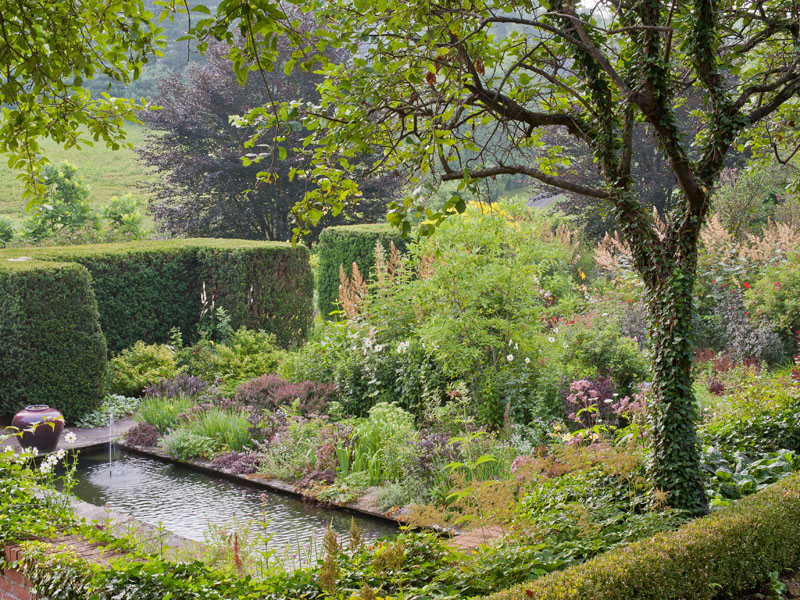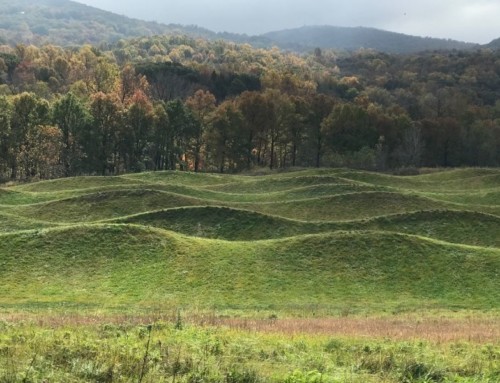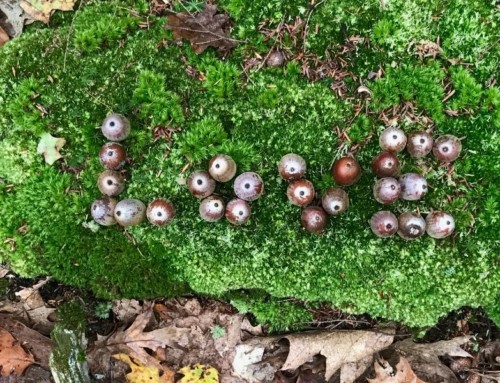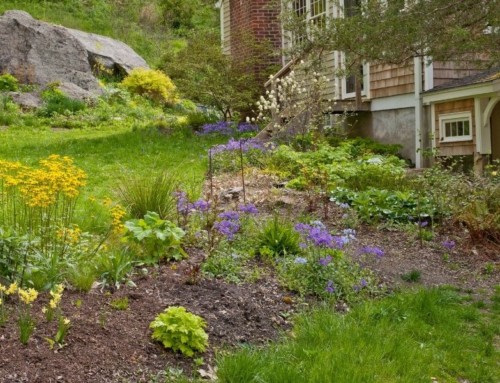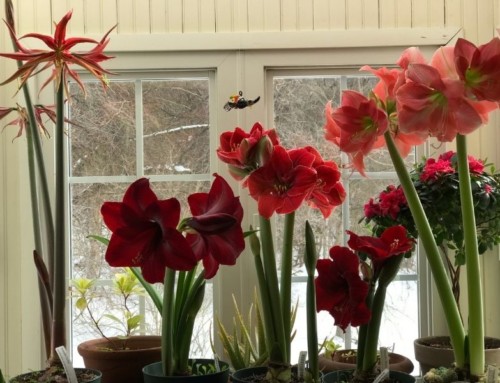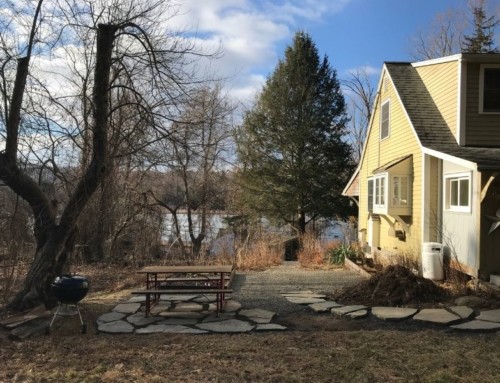When I was young I had lots of energy but no money and little experience. I made gardens everywhere I lived in my rootless youth but hadn’t seen many.
As my career blossomed, I spent days on end traveling, photographing amazing gardens all over the country and in Europe.
I had inspiration, money and lots of ideas, but little time, although I still had energy to make the most of it while my son was little.
I’ve often wondered if I could create something as original and satisfying as the ambitious gardens I’ve learned so much from if I could start over.
What if money, time, less challenging land and energy all came together at once? If I could do anything, what would it be?
But I’m rooted into this land, the breakneck acre and a half I’ve spent 30+ years getting to know. And I’m probably better at responding to what is than at pure invention.
My balance, strength and energy aren’t what they used to be – and I still don’t have time.
But I’m still full of ideas and imagination, even as I’m letting go of grand ambitions.
It’s time to refine, let ideas percolate, get a handle on how much I can realistically take care of – at least until I launch the next ridiculous project.
Having studied painting rather than horticulture or landscape design, I long thought of myself as a self-taught gardener as I felt my way along the convoluted path to where I am today.
But that’s not quite right.
Gardens and other gardeners have been my teachers. (I can say I’m a self-taught pianist, which is why I can plunk out a tune with my right hand but still don’t know what to do with my left).
Wide-Ranging Experiences
I’ve been re-reading Range: Why Generalists Triumph in a Specialized World by David Epstein.
This intriguing book “makes a compelling case for actively cultivating inefficiency” and explores how generalists often find their path late, juggle many interests, are more creative, more agile and able to make connections their more specialized peers can’t see.
An unruly mind, elliptical thought process and innate, unrelenting curiosity has taken me to all sorts of interesting places.
Who knew that inefficiency could be one of my finer qualities?
I’m drawn to people who think sideways and aren’t afraid to change course – even if it means ripping out parts of the garden that don’t work. Old gardens are so satisfying. Early mistakes are all gone or covered up with plants.
The gardens that most intrigue me were made by similarly “self-taught” gardeners who spent serious time looking, developed their very personal gardens over time and who never stopped learning, looking and sharing.
Some of my favorite “self-taught” gardeners have written about what I always want to know – the stories, the whys and hows, the big ideas and little pleasures along their garden-making journeys.
And they have often welcomed visitors to their garden through The Garden Conservancy’s Open Days Program and hopefully the day will come when they will again.
THE GARDENS AND THE GARDENERS
Lynden Miller
Esteemed public garden designer Lynden Miller once described to me how she was a painter when she went to live in England.
She returned home a gardener and garden designer after the artistry and plantsmanship of English gardens opened her eyes. Her own Connecticut garden just keeps getting better and better.
Read about Lynden Miller’s work and her book Parks, Plants and People: Beautifying the Urban Landscape.
George Schoellkopf, Hollister House Garden
George Schoellkopf, a retired 18th century American antique expert, was likewise smitten with English gardens.
Inspired by Sissinghurst, Great Dixter and Hidcote gardens, his interpretation is rooted, with impeccable taste and a sublime sense of proportion, in the terrain, history and climate of New England.
His Hollister House Garden (see photo above) in Washington, Connecticut is a series of garden rooms constructed over many years. They invite exploration and take a few quirky turns, stepping down the steep hillside of what one writer called 25 “tilted acres.”
Even from above you don’t see the whole garden at once; it lures you in and beckons, unfolding with surprise views and passages through doors and windows piercing tall hedges and walls of old brick and weathered stone.
Buildings, intimate spaces and structures, sweeping views of the opposite hillside and surrounding woods and fields – it’s a jewel set perfectly in a bucolic landscape.
All sorts of interesting herbaceous and woody plants are combined with romantic artistry verging on wild abandon. As George once said to me, you can be really loose with planting because of that formal structure.
Hollister House Garden, now a non-profit entity, will be donated to The Garden Conservancy. Memberships workshops and reasonable entry fees (during the season) raise funds to ensure its preservation.
Bill Noble, Norwich, Vermont
If Bill Noble, author of the recently published Spirit of Place: The Making of a New England Garden hadn’t already had me with the gorgeous cover photo of his Norwich, VT garden, his first words would have drawn me in.
“I’m going to tell you a story of the pleasures and challenges, both aesthetic and practical, of creating a garden that feels genuinely rooted to its place.”
Noble, Director of Preservation for The Garden Conservancy, also describes himself as a self-taught gardener, without “the advantage of a course of study in design or horticulture.”
He describes his garden as “an amateur’s garden” where close to 30 years later he continues to experiment with plants and ideas.
CLICK HERE to see where an always open “beginner’s mind” has led.
His gardening life “began in the gardens of artists who were primarily interested in creating outdoor places in which to live and work, where they could be close to nature and the elements, atmosphere and light, with a fullness of plants.” Gardens full of virtuosity and emotion, of satisfaction in the process of garden-making itself.
But his back story traces a journey from suburban Connecticut, down cow paths, into the woods, up and down mountain trails, to a graduate program in medieval studies, jobs working construction, cabinetmaking, community organizing and finally market gardening, a “temporary” job working in the gardens of sculptor Augustus Saint-Gaudens in Cornish, NH and visits to Italian gardens.
Quite a range of experiences.
Mary and Gordon Hayward, Putney, Vermont
Mary and Gordon Hayward’s 2005 book, The Intimate Garden: Twenty Years and Four Seasons in Our Gardens describes their process of restoring a derelict farmhouse in Putney, VT, surrounding it with gardens that reflect their roots, personalities, life together and history of the place.
The story of how they created a New England-meets-Old England garden becomes “a guide to making the right garden for your land.”
Mary grew up on a farm in England’s Cotswalds, gardening with her mother. Gordon’s family operated an apple orchard, not far from where I live in Connecticut, still family-owned.
He once described to me how his and Mary’s garden education started in their early days together, travelling around Europe visiting gardens.
Upon returning to Mary’s village, Gordon took a job restoring a badly neglected manor house garden while Mary worked in a tea room at The Hidcote Manor Gardens across the field from where they lived.
On weekends they visited garden after garden across southern England. What an education that must have been!
Speaking with Gordon recently, I mentioned how “self-educated” gardeners seemed to make gardens that are so personal, original and resonant, with layers of meaning and deep connection to the land, how they so often translate ideas from another place to their home ground without being too literal about it.
His response, “That’s the heart and soul that formal training often takes out of you – and that said by an English teacher of 17 years.”
Gordon, long-time English teacher and amateur-become-professional garden designer and writer, keeps that “always learning, always looking” amateur mindset. His many books (one of which, Art and the Garden, includes my garden) convey ways of looking at garden design with simple, intelligent clarity.
The Intimate Garden is full of sensible advice and questions that gardeners often don’t think to ask themselves.
“Do curved bed edges curve for a reason – around a tree, boulder or large shrub – or do they just curve for the sake of curving?” and “What is the relationship of lawn shape to bed shape? Are the two related and in proportion or is the bed too small for the lawn?”
I always keep in mind, when working with clients and in my own yard, Gordon’s admonition that a garden should be full of active prepositions.
“Walk through a gate, under overarching branches into sunlight, around a curve in a path. A house should be nestled in a garden as opposed to on a building site.”
Nothing should just sit there – always the English teacher.
For more information about their books and work, CLICK HERE to visit the website.
